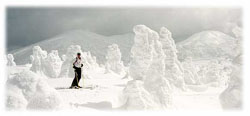
Hike, Huck and Soak
Backcountry skiing in Hakkoda, Japan...
February 21, 2006

|
|
| Japan's Backcountry Guru, Simon Bernard Photo Courtesy of Simon Bernard |
|
So you've heli-skiied Alaska and gone off-piste at Silverton in Colorado. You want something fresh and new, steep and deep--an out-of-bounds adventure with no parallel. Well dust off your passport and pull out your credit card, freshies abound in Japan's backcountry.
Not really a secret anymore (the cat was officially let out of the bag in National Geographic Adventure's article “Japan's Backcountry Dojo”), Hakkoda, the northernmost mountain range on the island of Honshu offers powederhounds endless fresh tracks. The weather there rolls out of Siberia to the north and across the Sea of Japan, meaning cold storms that dump more than 500 inches of snow in a season. That's 100 inches more than the average at Squaw Valley or Vail. And while the tallest mountain in the range, Mount Odake, tops out at a stout 5,200 feet, runs average four to six miles long. Imagine a six-mile long faceshot.
There are a couple of lifts and a gondola known as the “ropeway” that carry riders up various peaks in Hakkoda, but skins and snowshoes are the best way to access the region's most epic terrain. Earning your turns gets you further from the masses and into bowls and tree runs that go on forever, provided you know where to go. There are a number of guide services that operate out of the area, but reportedly only one guide who speaks English, Simon Bernard. Simon's an American ex-pat who has been living in the region for 15 years and guides two-plankers, freeheelers and knuckledraggers alike (Simon is now a snowboarder). He knows the best bowls and when to ride them and if you're a snowboarder, he'll steer you away from the dreaded flats that can leave you post-holing your way to steeper terrain. Check out his website at www.hakkodapowder.com for more information.
"Imagine a six-mile long faceshot!" |
Since Hakkoda is the backcountry, being prepared is always key. The area is known for its dangerous volcanic vents, as deadly and scary as any crevasse. The backcountry and massive amounts of snow also mean avalanche danger. So, when heading for a ski adventure in Hakkoda don't forget your beacon, shovel and probe. Even with a guide it's worthwhile to invest in maps and a compass and, if your pockets are deep enough, a GPS wouldn't hurt either. Simon also recommends emergency gear, like an emergency blanket, extra clothes and food.
You can fly pretty close to Hakkoda via Tokyo's domestic airport, Haneda, then on to Aomori, the northern prefecture where the mountain range is located. For the more budget-conscious there are both buses and Trains from Tokyo to Aomori. The bullet train is pretty fast, around four hours. There are plenty of places to stay while skiing at Hakkoda, from western-style hotels near resorts like Niseko to more traditional Japanese hot springs called Onsen. There are a number of Onsen in Aomori Prefecture, including Sukayu, which boasts a 1,000-person tub, not the place to go if you're shy or modest. Others include Yachi Onsen and Tsuta Onsen. Finding all of the information you need to book a stay at one of these places might be a bit more difficult that a western-style hotel, but the benefits far outweigh the frustration. Tea, hot baths and good, simple, traditional food will make coming off a long, hard day on the mountain a delight. Quirky Japan offers some contact information and descriptions of the aforementioned Onsen, but asking your guide always comes in handy too.
However you get there, skiing Hakkoda is a great detour for those stateside-spring skiing blues.
By Leah Greenstein
IN THE NEWS |
|
| |
|